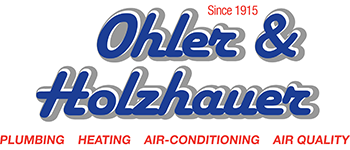
Ceiling fans are one of the most underrated ways to increase home comfort and lower energy costs. By enhancing air circulation and supporting your HVAC system, ceiling fans and energy efficiency are truly a perfect combination. They offer a practical, cost-saving way to stay cool while reducing strain on your AC—helping you avoid unnecessary air conditioning repair.
In this blog, the experts at Ohler & Holzhauer Inc. explain how ceiling fans can make your home feel more comfortable while lowering your energy use with higher HVAC efficiency. We'll also provide some HVAC efficiency tips that put to good use ceiling fans.
Comfort vs. Temperature: The Effect of the Wind-Chill Effect Indoors
Ceiling fans don’t actually lower the room temperature—they cool you down by increasing air movement across your skin. This is called the wind-chill effect, and it can make a room feel up to 4 degrees cooler without adjusting the thermostat. That means you feel less hot and enjoy the benefits of indoor air circulation from your ceiling fan while minimizing air conditioner use—helping reduce your electric bill in summer.
The Best of Both: Advantages of Pairing Fans and Air Conditioning Together
There are several benefits to using ceiling fans and air conditioning in tandem, especially on hotter days. By pairing both, you maximize HVAC efficiency and enjoy a cooler living space with less strain from your cooling system.
Benefits of using ceiling fans and AC together:
- Ceiling fans help lower HVAC load by distributing cool air more evenly around the room. Limiting HVAC stress is important, because it can help you avoid a breakdown that could result in premature AC or furnace installation.
- Using overhead fans improves your indoor comfort by reducing uneven temperatures and increasing airflow.
- Combining ceiling fans and AC can lower your utility usage. If you have a home automation system, you can even adjust your smart thermostat settings to set the temperature higher while your ceiling fan is running.
Clockwise vs. Counterclockwise Ceiling Fan Rotation: Which is the Correct Direction?
To make full use of your ceiling fans year-round, it’s important to ensure blades are rotating in the proper direction for the season. The direction affects how air moves, which can either cool you down or push warm air downward so you feel warmer.
When to rotate ceiling fans counterclockwise
On hot days, ceiling fans should spin counterclockwise at a quick speed. This creates a breeze that forces cool air down, enhancing the wind-chill effect and causing you to feel cooler.
When to rotate ceiling fans clockwise
In the winter, set your fan to spin clockwise on a gentle setting. This softly moves cold air up and draws warm air downward from the ceiling, making the space feel cozier without changing your thermostat.
Things to Look for in a Ceiling Fan
Picking the ideal ceiling fan depends on a few key factors, such as blade design, airflow rating and room dimensions. First, look for fans that have a good blend of ECFM airflow and blade pitch to deliver efficient air movement in your home:
- ECFM refers to the amount of air a fan pushes—the cubic feet per minute, or CFM—per watt of electricity it uses. Fans with greater ECFM are more energy efficient.
- Blade pitch is the incline of the blades. A sharper blade pitch moves more air but can also stress the fan’s motor.
Also, consider room size when sizing a ceiling fan—a fan that’s too small won’t move as much air as you'd like, while one that’s too large may be overpowering for the room.
Boost Your HVAC Efficiency With the Team from Ohler & Holzhauer Inc.
At Ohler & Holzhauer Inc., our HVAC technicians can help you enjoy year-round comfort while reducing strain on your heating and cooling systems. From energy-saving ceiling fan tips and air conditioning installation to smart thermostats and furnace repair, we offer comprehensive solutions that match your needs. Reserve your appointment by calling 419-732-2121 today.
